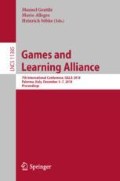Abstract
This paper focuses on the use of Augmented Reality technologies in relation to the introduction of game design elements to support university medical students in their learning activities during a human anatomy laboratory. In particular, the solution we propose will provide educational contents visually connected to the physical organ, giving also the opportunity to handle a 3D physical model that is a perfect reproduction of a real human organ.
Access this chapter
Tax calculation will be finalised at checkout
Purchases are for personal use only
References
Turney, B.W.: Anatomy in a modern medical curriculum. Ann. R. Coll. Surg. Engl. 89(2), 104–107 (2017). https://doi.org/10.1308/003588407X168244
Maresi, E.A., Argo, A.M., Spanò, G.P., Novo, G.M., Cabibi, D.R., Procaccianti, P.G.: Anomalous origin and course of the right coronary artery. Circulation 114(22), e609–e611 (2006). https://doi.org/10.1161/CIRCULATIONAHA.106.634667
Azer, S.A., Eizenberg, N.: Do we need dissection in an integrated problem-based learning medical course? Perceptions of first-and second-year students. Surg. Radiol. Anat. 29(2), 173–180 (2007)
Saguto, D., et al.: Survey on the demand of Sicilian physicians for a specific training on human cadavers and animals. EuroMediterranean Biomed. J. 13(3), 9–14 (2018)
Yammine, K., Violato, C.: A meta-analysis of the educational effectiveness of three-dimensional visualization technologies in teaching anatomy. Anat. Sci. Educ. (2014). https://doi.org/10.1002/ase.1510
Arrigo, M., Kukulska-Hulme, A., Arnedillo-Sánchez, I., Kismihok, G.: Meta-analyses from a collaborative project in mobile lifelong learning. Br. Educ. Res. J. 39, 222–247 (2013). https://doi.org/10.1080/01411926.2011.652068
Adams Becker, S., Cummins, M., Davis, A., Freeman, A., Hall Giesinger, C., Ananthanarayanan, V.: NMC Horizon Report: 2017 Higher Education Edition. The New Media Consortium, Austin (2017)
Arrigo, M., et al.: HeARt mobile learning. In: Gómez Chova, L., López Martínez, A., Candel Torres, I. (eds.) Proceedings of EDULEARN18, 10th International Conference on Education and New Learning Technologies, pp. 10899–10905 (2018). ISBN: 978-84-09-02709-5
Di Paola, F., Milazzo G., Spatafora, F.: Computer aided restoration tools to assist the conservation of an ancient sculpture. The colossal statue of Zeus enthroned. In: International Archives of Photogrammetry, Remote Sensing and Spatial Information Sciences, XLII-2/W5, Ottawa, Canada, pp. 177–184 (2017)
Di Paola, F., Pizzurro, M.R., Pedone, P.: Digital and interactive learning and teaching methods in descriptive geometry. Procedia Soc. Behav. Sci. 106, 873–885 (2013)
Graafland, M., Schraagen, J., Schijven, M.: Systematic review of serious games for medical education and surgical skills training. Br. J. Surg. 99(10), 1322–1330 (2012)
Spielberg, B., Harrington, D., Black, S., Sue, D., Stringer, W., Witt, M.: Capturing the diagnosis: an internal medicine education program to improve documentation. Am. J. Med. 126(8), 739–743 (2013)
Johnson, C.I., Bailey, S.K.T., Van Buskirk, W.L.: Designing effective feedback messages in serious games and simulations: a research review. In: Wouters, P., van Oostendorp, H. (eds.) Instructional Techniques to Facilitate Learning and Motivation of Serious Games. AGL, pp. 119–140. Springer, Cham (2017). https://doi.org/10.1007/978-3-319-39298-1_7
Author information
Authors and Affiliations
Corresponding author
Editor information
Editors and Affiliations
Rights and permissions
Copyright information
© 2019 Springer Nature Switzerland AG
About this paper
Cite this paper
Argo, A. et al. (2019). Augmented Reality Gamification for Human Anatomy. In: Gentile, M., Allegra, M., Söbke, H. (eds) Games and Learning Alliance. GALA 2018. Lecture Notes in Computer Science(), vol 11385. Springer, Cham. https://doi.org/10.1007/978-3-030-11548-7_38
Download citation
DOI: https://doi.org/10.1007/978-3-030-11548-7_38
Published:
Publisher Name: Springer, Cham
Print ISBN: 978-3-030-11547-0
Online ISBN: 978-3-030-11548-7
eBook Packages: Computer ScienceComputer Science (R0)

